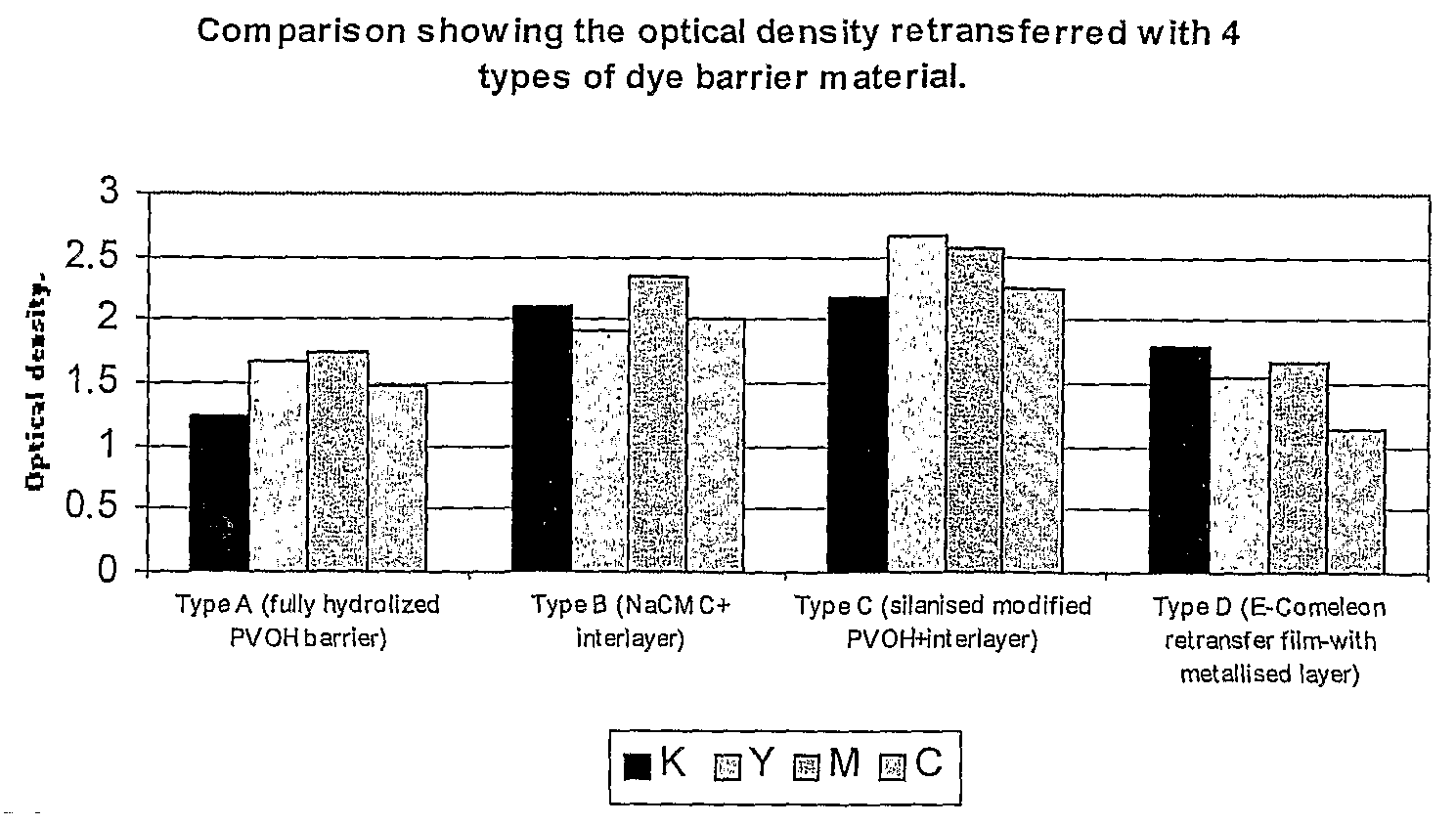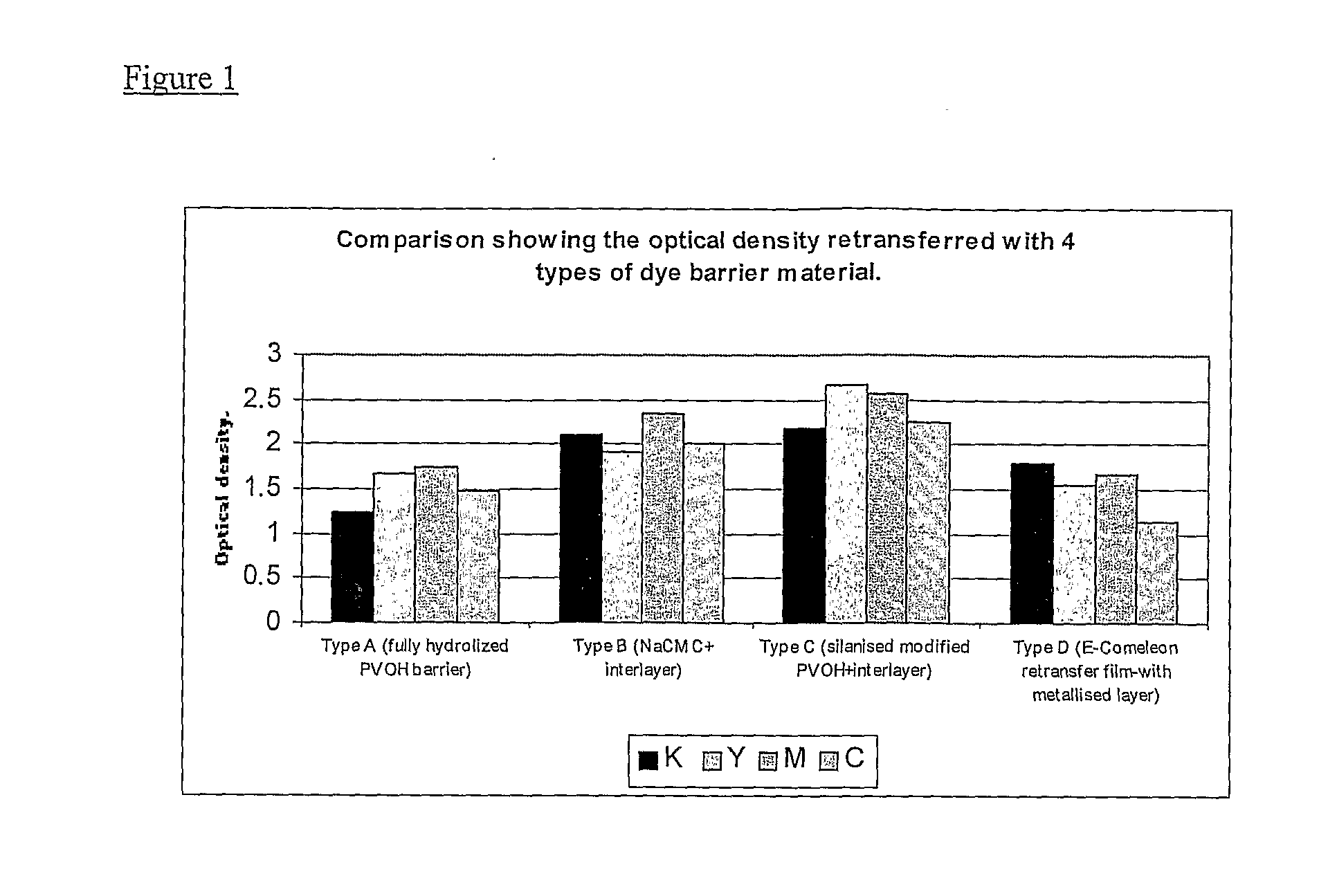Thermal transfer printing
a technology of thermal transfer printing and thermal transfer film, applied in the field of thermal transfer printing, can solve the problems of low efficiency retransfer film, reduced adhesion of fluid-absorbing layer, and washed-out appearance of retransferred images, and achieve the effects of preventing loss of adhesion on deformation, improving adhesion of fluid-absorbing layer, and facilitating the transfer of materials
- Summary
- Abstract
- Description
- Claims
- Application Information
AI Technical Summary
Benefits of technology
Problems solved by technology
Method used
Image
Examples
example 1 (
Type B)
[0050]One embodiment of a heat-deformable retransfer intermediate sheet in accordance with the present invention was prepared as described below. The sheet comprised a heat-deformable substrate coated sequentially with a prime layer, a fluid absorbing layer, a flexible interlayer and a dye management layer.
[0051]Substrate
[0052]The substrate comprised A3 size sheets of PET ‘A’, a clear 150 micron thick amorphous grade of polyethylene terephthalate film supplied by Ineos Vinyl.
[0053]The following coatings were applied in sequence using a number 4 Meyer bar. All coatings were oven dried at 60° C.
[0054]Prime Layer
[0055]A polyester resin having a Tg of less than 50° C. in the form of an aqueous dispersion (Vylonal MD-1400 from Toyobo) was applied to the substrate to produce a coat 1 micron thick. The resin is highly flexible and allows the fluid absorbing layer to adhere to the substrate.
[0056]Fluid-Absorbing Layer
[0057]The fluid absorbing layer was prepared from the following for...
example 2 (
Type C)
[0084]A further embodiment of heat-deformable retransfer sheet in accordance with the invention was prepared as described in Example 1, but using a different dye management layer and a different flexible interlayer.
[0085]The flexible interlayer was prepared from the following formulation.
[0086]Deionised water—76%
[0087]Industrial methylated spirit—20%
[0088]Celvol W25 / 190—4% (polyvinyl alcohol resin)
[0089]The formulation was prepared as follows:
[0090]Cold deionised water was measured into a mixer fitted with a heater jacket. The Celvol W25 / 190 resin was then dispersed into the cold deionised water using a paddle mixer. Using the heater jacket, the solution temperature was then raised to 95° C. The solution temperature was maintained at this level for a further 30 minutes to ensure complete solvation. The solution was then cooled to 25° C. The industrial methylated spirit was then added and the solution was mixed.
[0091]A coating 0.5 microns thick was formed on the fluid-absorbin...
example 3 (
Type A)
[0099]A further heat deformable retransfer sheet, not in accordance with the invention, with a dye management layer based on fully hydrolysed polyvinyl alcohol was prepared generally as described in Example 1 for comparative purposes.
[0100]A dye management layer with a coat thickness 1.5 micron was produced using the following formulation.
[0101]Deionised water—94.8%
[0102]Mowiol 20 / 98—5% (binder)
[0103]Syloid ED3—0.17% (amorphous porous silica gel)
[0104]The formulation was prepared as follows:
[0105]Cold deionised water was measured into a mixer fitted with a heater jacket. The Mowiol 20 / 98 resin was then dispersed into the cold deionised water using a paddle mixer. Using the heater jacket, the solution temperature was then raised to 95° C. The solution temperature was maintained at this level for a further 30 minutes to ensure complete solvation. The solution was then cooled to 25° C.
[0106]The final stage in the solution preparation process is the dispersion of the Syloid ED3 s...
PUM
| Property | Measurement | Unit |
|---|---|---|
| thickness | aaaaa | aaaaa |
| thickness | aaaaa | aaaaa |
| thickness | aaaaa | aaaaa |
Abstract
Description
Claims
Application Information
 Login to View More
Login to View More - R&D
- Intellectual Property
- Life Sciences
- Materials
- Tech Scout
- Unparalleled Data Quality
- Higher Quality Content
- 60% Fewer Hallucinations
Browse by: Latest US Patents, China's latest patents, Technical Efficacy Thesaurus, Application Domain, Technology Topic, Popular Technical Reports.
© 2025 PatSnap. All rights reserved.Legal|Privacy policy|Modern Slavery Act Transparency Statement|Sitemap|About US| Contact US: help@patsnap.com


